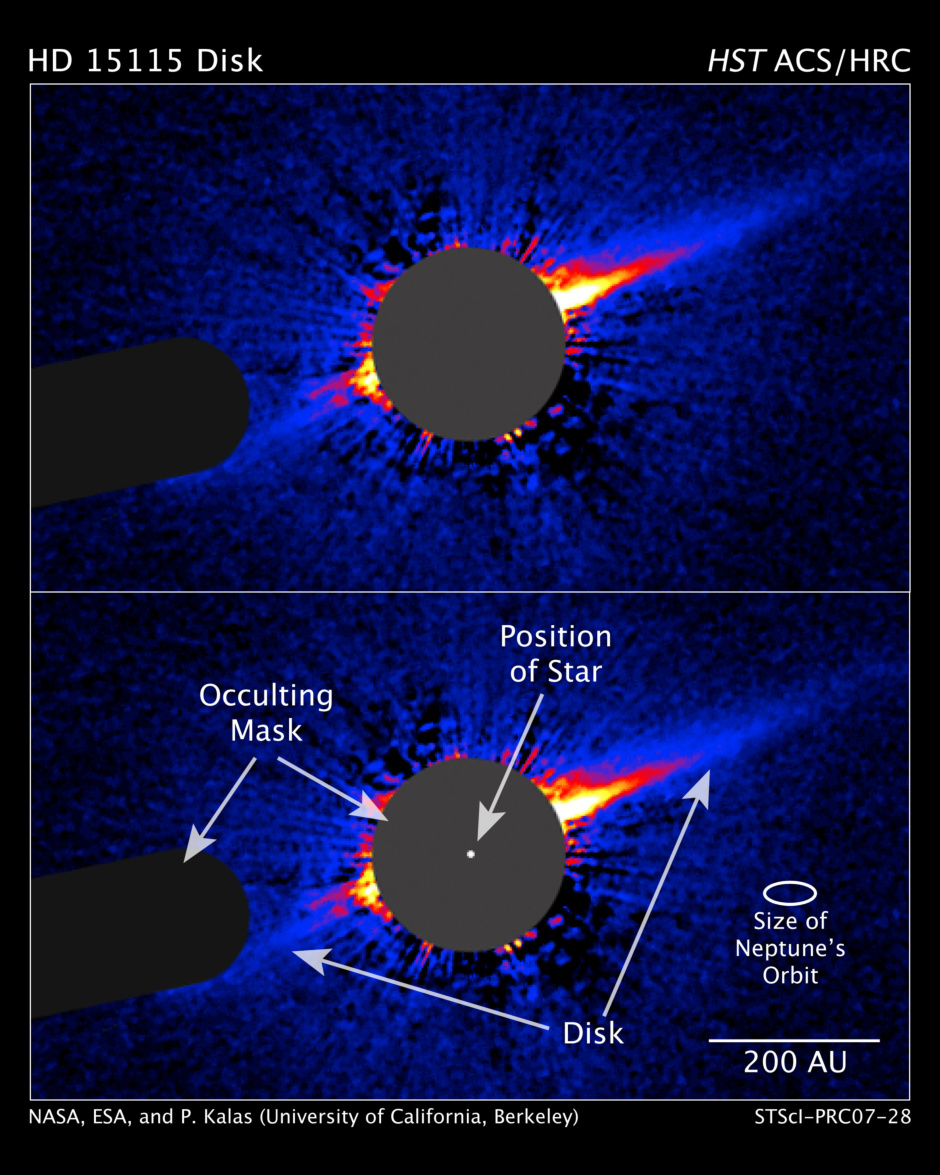천문학자들이 허블우주망원경과 W. M. Keck 천문대의 관측을 통해 HD 15115라고 알려진 젊은 별 주변에서 굴곡이 매우 크게 이그러진 타원형의 먼지 Disk를 발견했다.
사진에서 보는바와 같이 Disk모서리는 별에 붙어있는 바늘처럼 보인다.
천문학자들은 이 Disk의 괴상한 불균형 양상이 별주위를 일그러진 타원형으로 공전하고 있는 행성의 중력에 의해 암석 부스러기들이 쓸려다니면서 형성된 것으로 추측하고 있다.이처럼 기울어진 Disk는 아마도 별 주위를 돌고 있을 행성의 중력이 잔해들을 쓸어내면서 발생했거나
근처에 있는 별의 중력에 의해서 생성되었을 것이다. 이것은 캘리포니아 대학의 폴 칼라스(Paul Kalas), 제임스 그레엄(James Graham), 마이클 피츠제럴드(Michael P. Fitzgerald)에 의해 관측되었으며 Astrophysical Journal Letters에 게재되었다. 칼라스는 기울어진 Disk가 천문학 이론가에게는 새로운 도전이라고 말했다. Disk를 구성하고 있는 잔해들은 행성이 형성되는 과정에서 행성 형성이전의 암석들이 충돌함으로써 발생한 것이다.
이러한 먼지Disk는 마치 목성의 중력이 소행성대에 영향을 미치는 것처럼 별보다는 가까이 위치한 행성의 영향을 받는 것일 수도 있다.
이러한 예측은 해왕성이 아마도 토성과, 천왕성의 중간에 위치해 있었을 것이라는 태양계 행성 생성 모델과도 일치하는 견해이다.해왕성은 그 공전궤도가 현재의 위치로 고정되기 전에 목성과 토성간의 중력작용에 의해 현재의 궤도로 밀려나온 것이라고 추측되고 있다. 칼라스는 "그러므로 우리는 그와같은 행성발생이 현재 HD 15115주변에서 일어나는 것이라고 추측할 수 있으며 이것으로 원판의 극심한 불균형 현상을 설명할 수 있다"고 말했다.
이처럼 행성들간의 강력한 상호 중력작용으로 인해 행성의 공전궤도가 매우 굴곡이 큰 타원형 공전궤도로 형성될 수도 있고, 심한 경우 행성을 성간 우주공간으로 밀어내는 원인이 될 수도 있을 것이다. 칼라스에 따르면 이러한 작용에 의해 행성의 공전궤도가 타원형으로 형성될 때 디스크의 나머지 부분들이 타원궤도의 형성을 방해하는 기재로 작용할 수도 있다고 말한다.
또한 칼라스는 HD 15115로부터 10광년 떨어진 곳에 위치한 HIP 12545로 알려진 별의 중력이 과거에 두 별이 서로 근접해 있을 때 이 Disk를 기울어진 모양으로 만들었을 것이라는 가설을 세우고 이에 대해 연구를 계속하고 있다. 이 먼지 디스크에는 최소한 100개의 별이 존재하는 것으로 추측되고 있는데 별로부터 뿜어지고 있는 강렬한 빛으로 인해 관측하기 어려운 점이 있고 그래서 여지껏 12개 미만정도가 연구되고 있다. HD 15115와 HIP 12545는 Beta Pictoris Moving Group에 속한 거의 30개의 별 들중 하나이다.Moving Group이란 성단의 확장개념으로서 우주공간에서 느슨한 형태로 묶여진, 동일 장소에서 생성된 비슷한 연령의 별무리를 말한다. HD 15115주위의 먼지 디스크는 처음에는 적외선파장 관측으로 그 존재가 유추되었다가(2000년), 2006년에 허블우주망원경이 처음으로 별빛이 비춰지고 있는 Disk를 관측함으로서 그 존재가 확인되었다.
그리고 이 디스크는 2006년과 2007년 Keck adaptive optics를 활용하여 더욱 자세히 관측되었다.칼라스는
"허블우주망원경의 데이터는 진작에 이 Disk의 존재를 나타내고 있었지만 그 모습이 너무 괴상할 정도로 일그러져 있어 존재를 확신할 수 없었습니다. 켁 천문대에서 몇번의 관측이 더 수행되고 나서야 그 Disk의 실체를 인정하게 되었습니다."라고 말했다.
위치 : 고래자리
거리 : 150 광년 (45 parsecs)
* '허블사이트'의 게시물들은 허블공식 사이트 http://hubblesite.org 의 글들을 기반으로 약간의 편집을 거쳐 만들어집니다.
본 내용은 2007년 7월 19일 발표된 뉴스입니다.
http://hubblesite.org/newscenter/archive/releases/2007/28/full/
원문>
Astronomers using the Hubble Space Telescope and W. M. Keck Observatory have found a lopsided debris disk around a young star known as HD 15115. As seen from Earth, the edge-on disk resembles a needle sticking out from the star.
Astronomers think the disk's odd imbalanced look is caused by dust following a highly elliptical orbit about the star. The lopsided disk may have been caused by the gravity of planets sweeping up debris in the disk or by the gravity of a nearby star.
The observations were made by Paul Kalas, James Graham, and Michael P. Fitzgerald, all from the University of California at Berkeley. Their paper appeared in The Astrophysical Journal Letters.
"The lopsided disk presents a host of new challenges for theorists," said Kalas.
Debris disks are produced by dust from collisions among protoplanetary bodies, which are the building blocks of planets. These dusty disks can be affected by planets nearer to the star, much as Jupiter's gravity affects asteroids in the asteroid belt.
This discovery is consistent with models for planetary upheavals in our own solar system, where Neptune may have originally formed between Saturn and Uranus. Neptune was eventually kicked out to its present location by a gravitational dance between Saturn and Jupiter before their orbits stabilized. "Therefore, we speculate that if such a planetary upheaval were occurring around HD 15115 at the present time, it could explain the highly asymmetric disk," Kalas said.
This might happen through a powerful gravitational interaction between planets that kicks one or more planets into highly elliptical orbits, or even ejects them into interstellar space. When the planet's orbit becomes elliptical through a violent upheaval, the rest of the disk can be disturbed into an elliptical shape, according to Kalas.
Kalas also is studying whether the gravity of a star known as HIP 12545, located about 10 light-years from HD 15115, may have created the disk's lopsided shape due to a close encounter in the past.
Dusty disks are known to exist around at least 100 stars, but because of the difficulty in observing material within the glare of a star, less than a dozen have been studied closely.
HD 15115 and HIP 12545 are among nearly 30 stars that belong to the Beta Pictoris Moving Group. Moving groups are expanded clusters of stars believed to have a common birthplace and age that are traveling loosely together through space.
The dusty disk around HD 15115 was first inferred by observations at infrared wavelengths in 2000 and its existence confirmed in 2006 when the Hubble Space Telescope (HST) resolved the disk in reflected light for the first time. The disk was investigated further using Keck adaptive optics in 2006 and 2007.
"The disk was seen in the HST data, but its appearance was so extraordinary we could not be certain that it was real. It took follow-up observations at Keck to confirm that it was a real disk," Kalas said.
CONTACT
For more information, contact:
Dr. Paul Kalas
University of California, Berkeley, Calif.,
510-642-8285; kalas@astron.berkeley.edu or
Dr. Michael P. Fitzgerald
University of California,
Berkeley, Calif., 510-643-8530; fitz@astron.berkeley.edu
'3. 천문뉴스 > 허블사이트' 카테고리의 다른 글
| 허블이 촬영한 목성의 대기변화 (0) | 2007.09.20 |
|---|---|
| 별들의 요람 NGC 4449 (0) | 2007.09.19 |
| 별의 최후의 흔적(행성상성운) (0) | 2007.09.19 |
| 허블이 촬영한 깊은 우주 (0) | 2007.09.08 |
| 베일 성운의 초신성 폭발 잔해 (0) | 2007.09.02 |
